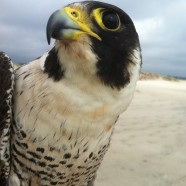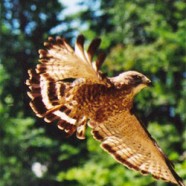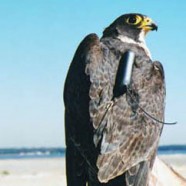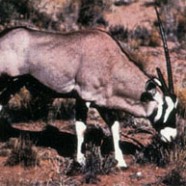54 Years of Peregrine Falcon Studies
Earthspan principals conduct long-term studies on migrating tundra Peregrine Falcons (Falco peregrinus tundrius) at Assateague Island, MD/VA (autumn since 1970) and Padre Island, TX (autumn and spring since autumn 1977). In 2019 we entered into a partnership with The Peregrine Fund to continue these studies. We have expended 59,010 man-hours of survey time in observing 75,304 peregrines and capturing 16,851. The tundra peregrine made a significant recovery and has been removed from the list of endangered species yet continued monitoring of populations is imperative. Because of the...
Read MoreHighly Pathogenic Avian Influenza Studies
We began a collaboration in December 2022 with Arnaud Van Wettere (DVM, MS, PhD, DACVP) at the School of Veterinary Medicine, Utah State University. Entitled Prevalence of Avian Influenza A Virus Antibodies in Migrating North American Peregrine Falcons, it is summarized thus: An outbreak of highly pathogenic avian influenza (HPAI) virus H5N1 started in the fall of 2021. The scale of this outbreak is unprecedented; it is the largest and most prolonged to date in the USA. Raptors are known to be particularly susceptible to HPAI, with most succumbing within a few days post infection. Given that...
Read MoreAnalysis of Mercury in Migrating Peregrines Published
With collaborators Joe Barnes of the Nevada Department of Wildlife and Shawn Gerstenberger of The University of Nevada at Las Vegas we have published our most recent assessment of mercury in feathers we collected 2009-2015 from migrating peregrines at Assateague (MD) and South Padre (TX) Islands. We detected mercury in all sampled fourth primary (range = 0.44–37.46 lg/g) and axillary feathers (range = 0.09–62.68 lg/g). The concentration associated with toxic effects in peregrines is unknown; however, peregrines have recently experienced broad population expansion across the presumed...
Read MorePolycyclic Aromatic Hydrocarbon Monitoring in Migratory Peregrines
The Deepwater Horizon Oil Spill (DWH) released an estimated 5 million barrels of oil into the Gulf of Mexico during April through July 2010. Earthspan and its partners, The Peregrine Fund and the University of Connecticut, collected and analyzed blood samples from migrating Peregrine Falcons at South Padre Island (TX) and Assateague Island (MD) to measure pre and post-spill concentrations of polycyclic aromatic hydrocarbons (PAH) from 2009-2011. PAHs are known to cause a variety of adverse eco-toxicological impacts that include acute toxicity, reproductive failures, DNA adducts, and...
Read MoreWintering area DDE source to migratory white-faced ibis revealed by satellite telemetry and prey sampling
Earthspan principals led a cooperative study to identify the source(s) of DDT-related contamination still plaguing a northern Nevada population of white-faced ibis many years after use of the pesticide was banned in the United States. The white-faced ibis (Plegadis chihi) is a long-legged wading bird that feeds primarily on invertebrates in wetlands and irrigated croplands. It is a highly social colonial nester and often forages in large aggregations. Due to restricted nesting habitat and potential vulnerability to pesticides, the species is listed by the U.S. Fish and Wildlife Service as a...
Read MoreBroad-winged hawk: Movements and habitat association during migration and wintering periods
Problem/Background Modern organophosphate insecticides are short-lived in the environment. These insecticides are toxic to raptors, but they are unlikely to be detected in animal blood or tissue unless the animals are sampled soon after exposure. Researchers postulate that pesticide exposures, and habitat alteration, in their wintering areas in Central and South America may be adversely affecting broad-winged hawk (Buteo platypterus, BWHA) populations, and those of other neotropical migrants. However, it is unknown whether broad-winged hawks concentrate in certain areas in their winter...
Read MoreSummary of Final Report: Study of Peregrine Falcons Wintering on the Gulf Coast of Mexico
Study of Peregrine Falcons Wintering on the Gulf Coast of Mexico
Read MoreSwainson’s Hawk: Scientific Research Rescues Species Before Threatened or Endangered Status Listing is Needed
Problem/Background The Swainson’s Hawk (Buteo swainsonii, SWHA) is listed as a species of concern by five states and the Bureau of Land Management, and as a special emphasis species by the U.S. Forest Service. Nesting population declines was reported over much of the SWHA range in the early 1990s. With no obvious reason for this decline, scientists postulated that problems along migration routes or on wintering areas were responsible. In 1995 and 1996, we monitored Swainson’s hawk distribution on and off military installations in the western U.S., where their numbers had been diminishing...
Read MoreA Study of The Golden Eagle in Mexico
Selected Passages from the Final Report to Proyecto ARA A.C. Introduction Mexico’s national bird, the golden eagle (Aquila chrysaetos), is classified as “in danger” in Article 9 of the Federal Hunting Law (SEDUE 1984) and Ramos (1986) classifies the population as declining, primarily due to decreases in habitat quality. Environmental pollution (particularly pesticides), direct persecution, and illegal trade are all thought to play a part in the decline (Ramos 1986). Although some information exists about the natural history of golden eagles in the southwestern United States of America,...
Read MoreSatellite Tracking Oryx
Accomplishments White Sands Missile Range, New Mexico White Sands Missile Range (WSMR) is the military’s largest all-overland test range in the Western Hemisphere and encompasses 2.2 million acres, which can be extended to 4 million acres (total) by including adjacent federal land holdings. WSMR houses the U.S. Army Research, Development, Test, and Evaluation (RDT&E) Command for weapons and space systems and components.Within WSMR are the San Andreas National Wildlife Refuge, White Sands National Monument (National Park Service), and Jordana Experimental Range (U.S. Department of...
Read More





